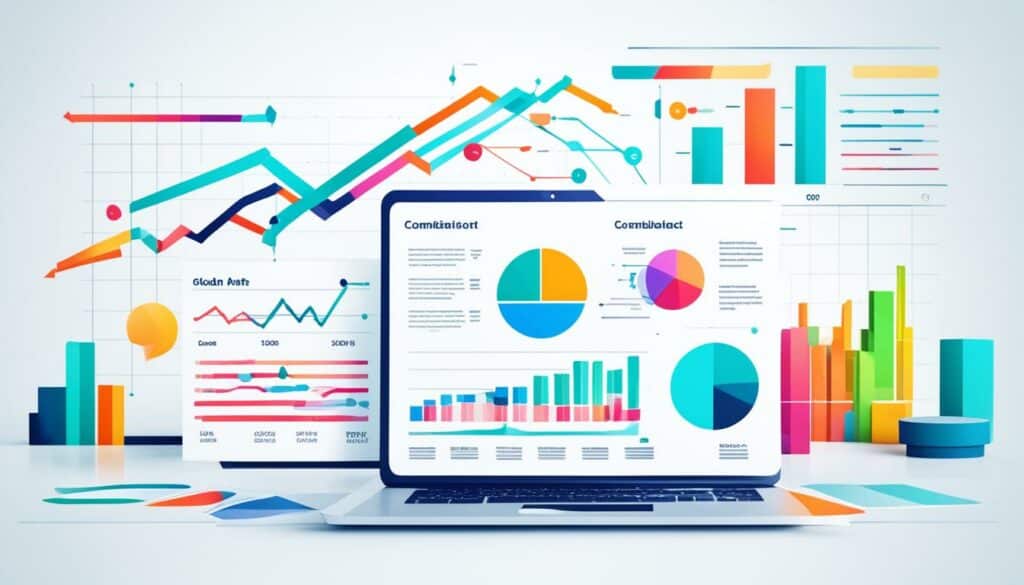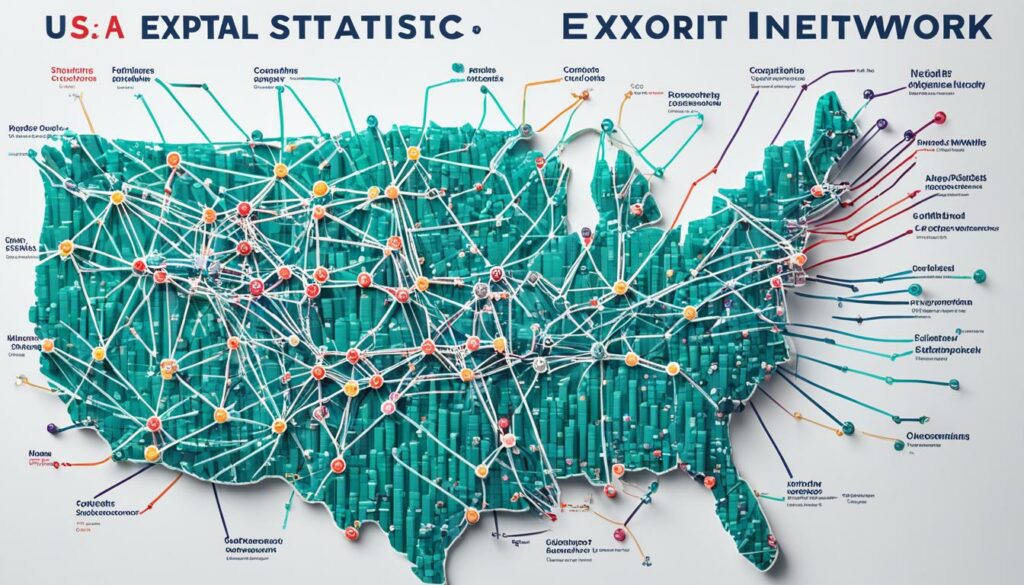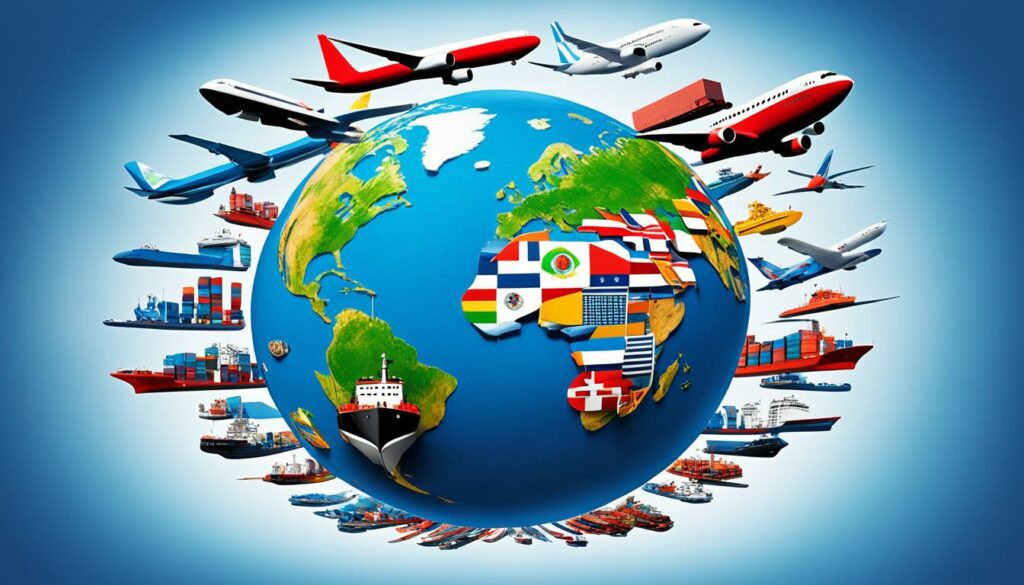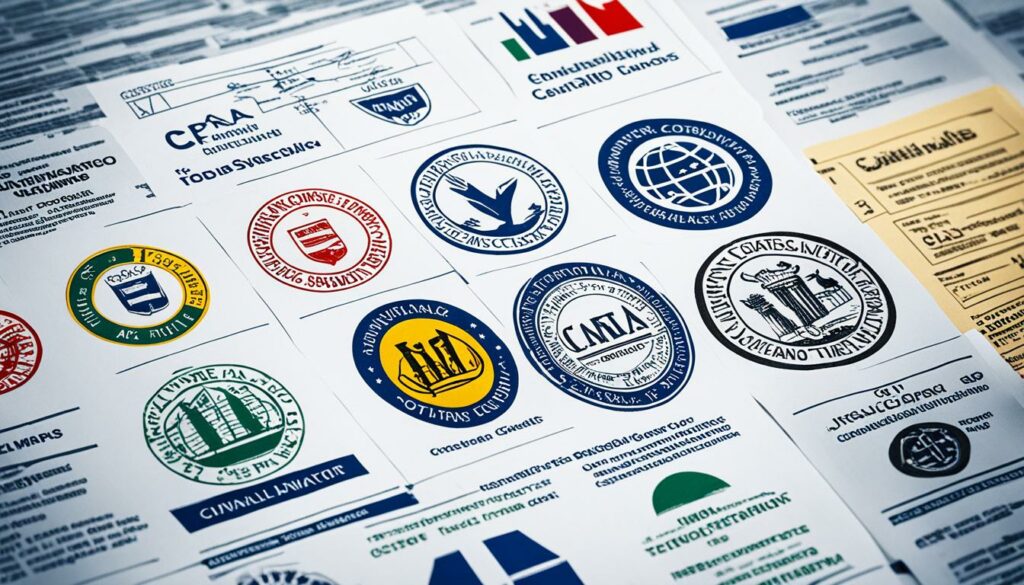Menu

Did you know that a staggering 97% of global customers live outside the United States? This shows the huge chance for U.S. businesses in international markets. Exploring these markets shows us huge chances but also big challenges. It takes sharp skills and good timing to do well.
My journey in global export markets mixes experience with data. People around the world want American goods and services because of their quality and new ideas. The Export Solutions Roadmap is key. It gives exporters tools to start, grow, and fund their international sales.
The U.S. Commercial Service from the International Trade Administration is a great help. They help businesses find markets, buyers, and guide them through deals and shipping. Benefits from Free Trade Agreements (FTAs) help too. They show the good things these deals can bring for business.
In May, during World Trade Month, efforts increase to promote learning about exports. This makes more people understand the benefits and ways of international trade. Knowing and following U.S. laws like the Foreign Corrupt Practices Act is very important. It shows how serious legal rules are for wide business strategies.
As businesses go global, understanding Exim data is vital. This data covers global imports and exports. It helps businesses make smart decisions by revealing important trade patterns.
Exim data gives us a close look at global trade. It includes importer and exporter details, product info, quantities, prices, and dates. This info is key for businesses wanting to enter new markets.
Take the USA, for example. It imports a lot in categories like computers, minerals, and electrical equipment. Knowing this helps companies plan their market entries well.
Using Exim data brings many advantages:
China is the top exporter and shipped $3.36 trillion in goods in 2021. Knowing this data helps in long-term strategy and staying ahead in global trade.
| Country | Main Exports |
|---|---|
| China | Computers, Telephones, Machine Parts |
| USA | Computers & Hardware Machinery, Minerals, Fuels & Oil, Electrical Equipment |
| India | Precious Stones, Gems, Jewellery, Petroleum Products, Pharmaceuticals |
Using advanced market research tools is vital for effective export marketing plans. These tools uncover what’s trending with consumers. They offer deep insights into different industries. This knowledge is key for launching winning campaigns globally.
Glimpse uses cutting-edge AI to give companies instant survey results. This means firms can act fast on what their consumers think. They get a clear view of which products will do well in their target areas.
Statista is famous for turning complicated data into easy-to-understand visuals. With a team of over 100 analysts, it tracks industry changes. These reports are a goldmine for discovering new market chances and beating consumer trends.

Think With Google puts Google Trends and Market Finder at your fingertips for free. These tools give vital info like what consumers prefer. They help businesses tweak their products to meet market needs better.
| Tool | Key Features | Pricing |
|---|---|---|
| Glimpse | Real-time survey insights, AI-powered analysis | $500 to custom pricing per month |
| Statista | Data visualisation, comprehensive reports | Various subscription plans |
| Think With Google | Google Trends, Market Finder | Free |
In short, using these tools with your export marketing boosts your chances for success. They help understand what’s popular with customers. And they give insights into different industries, making your global steps more sure-footed.
Seizing international trade chances requires a detailed strategy. Learning about different markets and the world’s trade policies is key. By looking at data and trends, companies can choose the best places to invest for success.
International trade is always changing, and some places are growing fast. For example, more investments are going to Africa and India. Businesses that explore these new markets can find great opportunities.
It’s smart for small firms to pick a few markets to check out. This way, they can use their resources well and have better success. Tools like the Harmonised System (HS) Code and data from industry groups can show where products are in demand.
The World Trade Organization (WTO) expects world trade to grow more slowly. Yet, it still predicts good chances for businesses.
The world’s politics affect trade greatly. Lately, China and Russia have seen fewer investments because of tensions and rules. These shifts highlight the need to keep an eye on global politics for better trading decisions.
Doing your own research by talking to contacts and buyers can give great insights. But it can be expensive. Using already available market data is a cheaper alternative. For American exporters, looking at U.S. export stats and what other countries import can offer a clear picture.
Platforms such as TradeStats Express can be very helpful. They show detailed data on exports from the U.S. and some states. This information can point businesses towards the best markets to focus on first. This way, they can use their money and time wisely.
The theory of comparative advantage, first explained by David Ricardo, is crucial. It says countries should focus on what they’re best at making. This has worked well throughout history for countries like England and Portugal.
Trade benefits everyone involved, leading to more jobs and bigger economies. But, sometimes people or groups ask for rules that protect their businesses from foreign competition. This kind of lobbying can be bad for the long run. It often makes trading harder and less fair for everyone.
Studying U.S. exports shows us how different sectors are doing. We also see where the top export spots are. This info is key for companies wanting to do better in global trade.

Knowing where the U.S. sells its goods and services matters a lot. The International Trade Administration offers detailed reports on 230+ trade partners each year. This helps businesses keep up with important market trends.
| Country | Goods Exported | Services Exported | Year-to-Date Change (%) |
|---|---|---|---|
| Canada | Machinery, Auto Parts | Travel, Financial Services | +5.2 |
| Mexico | Automobiles, Electronics | Transportation, IT Services | +4.8 |
| China | Aircraft, Soybeans | Business Services, IP Licenses | -3.0 |
Knowing about trade trends is vital for companies wanting to do well. The Manufacturing Industry Tracker watches 21 areas. It shows data on U.S. exports, imports, and more.
The car industry, for example, is selling more in new markets. This shows people want cars made in the U.S. But, the energy market is up and down due to oil prices. There is a tool that tracks steel imports, helping firms understand the steel market’s ups and downs.
Using these details, companies can plan better. They can choose how to adjust their work based on what’s happening in their field. Also, they can see where they might have the best chance to sell more.
“The Monthly Infographic and Partner Trade Tables consistently provide actionable insights, empowering exporters to stay ahead in the global market.”
Analysing foreign import statistics is key in international market studies. It starts with getting trade numbers to see the market size and find chances. This also helps businesses spot the ideal markets to enter, looking at their size and growth.
In-depth international market analysis means checking what each country wants and how they buy. This shows which places are open to new products. For example, checking U.S. exports against foreign imports helps companies see where U.S. goods might do well.
Knowing how much and what is being bought is vital. By using data on things like population and money, companies can figure out where to focus. This is especially helpful for smaller firms wanting to find promising markets.
Looking at import details closely involves using helpful tools. The Global Trade Atlas (GTA) and TradeStats Express offer ways to keep an eye on important numbers. Comprehension reports from Industry & Analysis give deep information on over 230 trade partners, crucial for planning.
Let’s see how detailed comparisons work with the right stats:
| Country | Total Import Value (in Billion USD) | Annual Growth Rate (%) | Top Imports |
|---|---|---|---|
| Germany | 1165.5 | 3.2 | Automobiles, Machinery |
| China | 2293.8 | 4.0 | Electronics, Machinery |
| United States | 2562.2 | 2.5 | Electronics, Apparel |
| India | 507.6 | 9.1 | Petroleum, Gems |
| Brazil | 160.4 | 8.4 | Machinery, Chemicals |
By comparing these details, clear strategies emerge. Tools like the U.S. Energy Trade Dashboard help in-depth sector research. This sharp analysis helps businesses craft strong export plans for better overseas growth.
Exploring what rival companies do is important in international markets. As the global competition gets tougher, understanding your competition’s advertising and export plans is key.

Studying Google Ads gives insight into what competitors are up to. By looking at their ads, keywords, and how they bid, we can learn a lot. We figure out how they look in different markets. And find good keywords for us as well as ways to respond.
| Ad Parameter | Insights | Action |
|---|---|---|
| Keywords | High volume keywords targeted | Optimise bid strategy |
| Ad Copy | Compelling offers and CTAs | Enhance ad creativity |
| Ad Placement | Top placements in search results | Focus on high-performing placements |
An organic competitors report shows the online strength of others. Using SEMrush and Ahrefs, we look at how well they do in search, their backlinks, and how their content works. This helps spot where we can do better and search better online.
“The rate of companies benefiting from attending trade shows to investigate competitors’ products and capabilities in export markets is significant. This underscores the need for continuous learning and adaptation.”
Seeing what ads work best and gaps in keywords helps a lot. We look at how their ads do and the keywords they miss. Fixing these gives us a better spot in the export market and stronger international marketing.
By deeply looking at competitor strategies using Google Ads tools, search stats, and keyword gaps, we build better plans for going international.
To grow internationally, businesses should use a mix of strategies for steady growth and to enter markets effectively. Access to current data helps companies make smart choices. Also, strong partnerships abroad set the stage for long-term success.
Companies aiming for deep market penetration need to use detailed trade data and insights. Setting up local offices or branches gives them control over their operations. This makes it easier to adapt to what local customers need.
Another good option is allowing foreign firms to use your business idea for a fee. This is helpful in industries like architecture, where big projects are completed. The process of training local staff ensures a smooth handover and operation of the project.
Also, working with agents or distributors can help reach customers in foreign lands. In 2022, the U.S. made more than $3 trillion from exports, showing that these methods work well for small and mid-sized companies.
Having partners overseas is key to growing globally. Joining with another company can share risks and strengths. Yet, it’s crucial to negotiate agreements carefully to prevent disagreements later.
Buying local businesses can give you quick access to customers and market knowledge. This speeds up entering new markets. Becoming part of global supply chains boosts a company’s worldwide reputation.
Dealing with risks like payment problems and currency changes can be made easier by using trade insurance. This kind of insurance protects against financial losses, helping companies stay stable as they grow.
Combining a data-focused approach with strong overseas partnerships is the way to achieve lasting global growth.
In the world of cross-border commerce management, dealing with many risks is tough. Since 2022, trade setups keep changing, which troubles companies. This makes handling risks in global trade very important.

The World Trade Organization (WTO) now has big problems. This shows that global trading is getting more complex. There are new chances in growing markets. But, rules like standards, where things come from, and taxes make it hard.
Political issues can slow down getting things like oil and goods. Also, the effects of COVID-19 mix into everything. Big lockdowns in exporting areas are still happening.
Transport prices are going up because of inflation. This is bad news for businesses trading internationally. They need to get better at handling problems to keep up.
Today, selling straight to buyers around the world is crucial. This means knowing international taxes, how goods pass through customs, and logistics really well. Giving clear prices and understanding all costs helps a lot. So does having good back-up plans and watching the market closely.
Trade between countries involves a lot of paperwork and rules. Different places have different needs. Luckily, there are smart tools to help with this.
Having a good way to handle returned items is also key for selling abroad. People expect to return things easily.
Global online shopping is growing fast. It got a big push from the pandemic. By 2027, the money spent on international transactions could double to $250 trillion. This makes it crucial to handle risks well and grab new chances in global business.
Effective trade compliance strategies need a deep understanding of international trade laws. They also require proactive legal compliance. Businesses have to dive into the regulatory world. They must set up strong systems to follow international regulations closely.

Adhering to international regulations is key for global trade success. Knowing the rules and staying updated helps avoid legal problems. It’s crucial to review and update SOPs regularly. This allows businesses to handle new issues quickly.
Legal compliance in international trade needs a layered strategy. In-house and external efforts are vital. Creating a strong compliance program involves several important steps. For instance, senior management should set standards and allocate resources.
Also, using data and technology can make customs tasks smoother and boost carrier success. Companies might develop their own compliance programme. They should also be willing to get help from third-party experts when necessary.
| Key Element | Description |
|---|---|
| Senior Management Involvement | Establish and document compliance standards, dedicate resources, appoint responsible officials. |
| Risk Assessments | Conduct regular risk assessments related to export activities. |
| EMCP Documentation | Ensure consistent guidance through a written compliance programme. |
| Employee Training | Provide ongoing compliance training for all employees. |
| Security Measures | Implement robust security measures and conduct thorough screenings. |
| Record-Keeping | Maintain thorough records to track and monitor compliance activities. |
| Compliance Monitoring | Conduct regular audits and assessments. |
| Reporting Issues | Handle and report compliance issues and violations promptly. |
Real-time data is key for smart decisions. It’s especially vital for global trade. A MIT study found that companies using data drive 4% more productivity and 6% higher profits. This shows real-time data is crucial for success today.
Data helps companies grow by setting clear goals. Real-time information offers quick market insights, allowing fast reactions to shifts and trends. A Google study shows huge differences in success between top and bottom managers based on how they use data.
International trade data helps find new chances and promotes innovation. It aids in making choices that lead to growth and fill market gaps. Using data also makes decision-making less risky, leading to better choices.
Avoiding a data-first approach can waste 70% of efforts to modernise a business. It often happens because companies put too much focus on tech, not data. An approach that values real-time data can help track goals effectively, making the best use of resources and driving innovation.
“Data-driven decision-making tools enable businesses to adapt to emerging trends and remain competitive in a constantly changing digital landscape.”
Good dynamic market analysis starts with quality data. Companies need to make sure their data is complete and accurate to avoid problems like misleading conclusions. While it might be tough to promote a data-focused culture, the advantages are many: stronger customer relationships, better planning, and savings in both time and money.
| Benefits | Statistics |
|---|---|
| Higher Productivity | 4% increase (MIT study) |
| Higher Profits | 6% increase (MIT study) |
| Organisational Growth | Empowers benchmark setting |
| Adaptability | Essential for remaining competitive |
| Risk Minimisation | Provides objective evidence |
| Enhanced Decision Making | Supports strategic planning |
Summing up, using real-time data strategically is crucial for staying ahead in global trade. With the right use of data, companies can not just survive but also flourish in the global market.
Looking at international trade case studies, big names stand out. McDonald’s, Coca-Cola, Samsung, Alibaba, and Toyota give us insights. They’ve tackled the challenges of global markets well.
McDonald’s shines in over 100 countries. They’ve shown that global growth can be done right. Tailoring their menu and model to fit local needs, they keep their brand renowned.
Wherever you go, you find Coca-Cola. This story of global triumph stresses the power of a clear brand message and strong distribution.

Samsung’s wins in electronics and shipbuilding prove that diversification and innovation work. Being at the forefront of technological trends, and a focus on R&D, has made them a market leader.
Adapting to local customs is key to success. Take Alibaba, for example. It went beyond China to unite global traders online. It’s a great model for building a wide trade network.
Toyota shows that in the car industry, efficiency and high standards win. They teach us the value of improving internal systems to deliver top-quality products consistently.
| Company | Industry | Key Success Factor |
|---|---|---|
| McDonald’s | Fast Food | Adapting to local tastes |
| Coca-Cola | Beverages | Strong distribution network |
| Samsung | Electronics, Shipbuilding | Diversification & Innovation |
| Alibaba | E-commerce | Connecting global buyers and sellers |
| Toyota | Automotive | Lean manufacturing |
These global expansion success stories and market expansion lessons are a guide for joining the international market. Learning from their strategies can help new global companies a lot.
In today’s world, boosting exports means getting the right data. Happily Trade EXIM does a fantastic job here. It gives detailed reports from over 80 countries. Businesses use this info to understand market trends and make smart choices.
Happily Trade EXIM shines with its rich set of tools for business:
Using Happily Trade EXIM well means including its data and tools in your plans:
With Happily Trade EXIM, businesses can build strong plans for more sales and lasting growth. A tool like this keeps you up-to-date on global trends. It lets you grab new chances as they come, making your moves smart and successful.
In the global market today, watching your rivals closely is key. Tools like AlphaSense are essential. They look at competitors’ strategies and prices. AlphaSense gives insights from over 10,000 sources worldwide. This helps businesses know what their rivals are doing and adjust their strategies.
Two more key tools are Klue and Crayon. Klue sends updates about what your competitors are up to. This keeps your business ahead. Meanwhile, Crayon gives quick info to sales and marketing teams. These tools look at things like links to your competitors’ websites and their online popularity. They start at $199 a month helping businesses make better decisions.
Crunchbase Pro also plays a big role in understanding your competition worldwide. It uses 38 filters to find what you need. Subscriptions start at $29 per user each month. Contify, on the other hand, covers data from over 500,000 sources. It is good for bigger companies in many fields like IT and finance. These tools together help companies keep up with global competition.
Prices for these tools vary a lot, from free to $1,999 per month. The average cost is about $64 per month. These tools offer many features, from listening on social media to planning your content. This helps businesses stay strong against competition. By knowing what others are doing, they are more likely to succeed and find new opportunities.
To succeed in global export markets, businesses need to understand market dynamics and political influences. They should use data from Exim wisely. Building strong international partnerships is also crucial.
Exim data helps businesses learn about market needs, find potential partners, and stay within the rules. Tools like Happily Trade EXIM give real-time updates. These are key for making smart decisions and keeping up in global markets.
Key tools for export marketing include Glimpse for fast survey insights, Statista for clear data visuals, and Think With Google for useful product info. These help companies understand new markets and meet what customers want.
Places like Africa and India are becoming big in international trade. It’s important to look at the politics of these areas. This can help find and make the most of trade chances.
By studying U.S. export stats, businesses can spot trends in different sectors. They can also find the best places to sell their products. This helps them tweak their plans to meet what the market needs.
Import stats tell businesses about market interest and demand. With this data, they can plan how to enter or grow in a market. They look at what’s already being bought and adjust their strategies.
Using tools that look at Google Ads and online visibility is key. This helps businesses understand what others are doing. They can then make plans to do better and get ahead in global markets.
Using up-to-date data and building strong international relationships are great strategies. Companies can use trade data to find new markets. They can also work closely with others globally to keep growing.
Dealing with risks in cross-border sales means planning for things like political changes and legal issues. Companies must keep an eye on international trade news to stay prepared.
Businesses should know the trade rules and always follow them. They need to watch for rule updates. Making sure everything they do is legal helps avoid problems.
Up-to-the-minute data is crucial for smart decision-making. When companies have the latest info, they can move fast and make the most of chances. This keeps them ahead and ready for whatever comes.
Success stories in international trade are very helpful. They show the way through global markets, pointing out what works and what to avoid. They offer lessons for smart expansion.
Happily Trade EXIM has all the global trade data you need, always updated. It helps with market research, finding partners, checking risks, and following the rules. It gives businesses an edge.
Watching what competitors are doing worldwide is key for staying in the game. It helps businesses make their own plans and jump on new chances in the global scene.